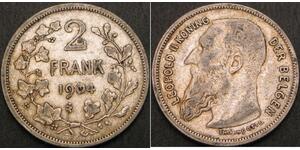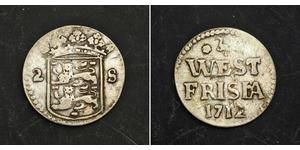1 Scudo (Verkauft für $385.0)
1744, Italy, Lucca (Republic). Large Silver Scudo Coin. aXF!
Mint Year: 1744
Denomination: Scudo
Reference: Davenport 1373, KM-53. R!
Condition: Lightly cleaned, otherwise about XF!
Weight: 26.84gm
Diameter: 42mm
Material: Silver
Obverse: Saint Martin on horseback left, offering his coat to beggar.
Legend: SANCTUS MARTINUS *
Reverse: Crown above arms of the Republic of Lucca (with "LIBERTAS" inscription) inside foliage, flanked by sprays in saltire.
Legend: LUCENSIS + RESPUBLICA + 1744 +
St. Martin of Tours (circa 316-397) was the son of a Roman tribune. While stationed at Amiens he came upon a starving, half-naked begger and, on impulse, sliced his rich cloak in twain and presented half to the poor man. His cult in the Middle Ages became a focus of Christian charity, and impressive cathedrals were raised in his name across Europe. His cathedral in Lucca was begun in 1060. Luccans took him as their patron saint during their struggles to remain independent from larger, more powerful neighbors such as Florence, Parma and Pisa. Napoleon put an end to over 400 years of independence in 1799.
Bid with confiedence!
The Republic of Lucca was an ancient State of Tuscany which lasted from 1160 to 1805. After the death of Matilda of Tuscany, the city of Lucca began to constitute itself an independent commune, with a charter in 1160. For almost 500 years, Lucca remained an independent republic. There were many minor provinces in the region between southern Liguria and northern Tuscany dominated by the Malaspina; Tuscany in this time was a part of feudal Europe. Dante’s Divine Comedy includes many references to the great feudal families who had huge jurisdictions with administrative and judicial rights. Dante spent some of his exile in Lucca. In 1273 and again in 1277 Lucca was ruled by a Guelph capitano del popolo (captain of the people) named Luchetto Gattilusio. In 1314, internal discord allowed Uguccione della Faggiuola of Pisa to make himself lord of Lucca. The Lucchesi expelled him two years later, and handed over the city to another condottiere Castruccio Castracani, under whose rule it became a leading state in central Italy. Lucca rivalled Florence until Castracani's death in 1328. On 22 and 23 September 1325, in the battle of Altopascio, Castracani defeated Florence's Guelphs. For this he was nominated by Louis IV the Bavarian to become duke of Lucca. Castracani's tomb is in the church of San Francesco. His biography is Machiavelli's third famous book on political rule. In 1408, Lucca hosted the convocation intended to end the schism in the papacy. Occupied by the troops of Louis of Bavaria, the city was sold to a rich Genoese, Gherardino Spinola, then seized by John, king of Bohemia. Pawned to the Rossi of Parma, by them it was ceded to Martino della Scala of Verona, sold to the Florentines, surrendered to the Pisans, and then nominally liberated by the emperor Charles IV and governed by his vicar. Lucca managed, at first as a democracy, and after 1628 as an oligarchy, to maintain its independence alongside of Venice and Genoa, and painted the word Libertas on its banner until the French Revolution in 1789. Lucca was the third largest Italian city state (after Venice and Genoa) with a republican constitution ("comune") to remain independent over the centuries.
The history of the Republic had a big changement after the French invasion in 1799. Jacobins imposed a democratic Constitution which gave the government to an Executive Directory, with a bicameral legislature composed by the Council of Juniors and the Council of Seniors. This situation did not last longtime: five months after, Austrian forces conquered the city and established a Provisional Regency. French Army finally returned in late 1800, and a new Constitution was published in 1801, restoring the office of Consul of Justice as president of the Executive, with a parliament called Great Council.
In 1805, Lucca was taken over by Napoleon, who put his sister Elisa Bonaparte Baciocchi in charge as Princess, merging the State with the Principality of Piombino.

|
Beigetragen von:
anonymous 2014-01-29 |
|
||
|
||
|
||
|
||
2 Franc Belgien Silber Leopold II (1835 - 1909)
Diese Gruppe hat 7 Münzen / 7 Preise
⇑
2 Stuiver Niederlande Silber
Diese Gruppe hat 2 Münzen / 2 Preise
⇑




 English
English















